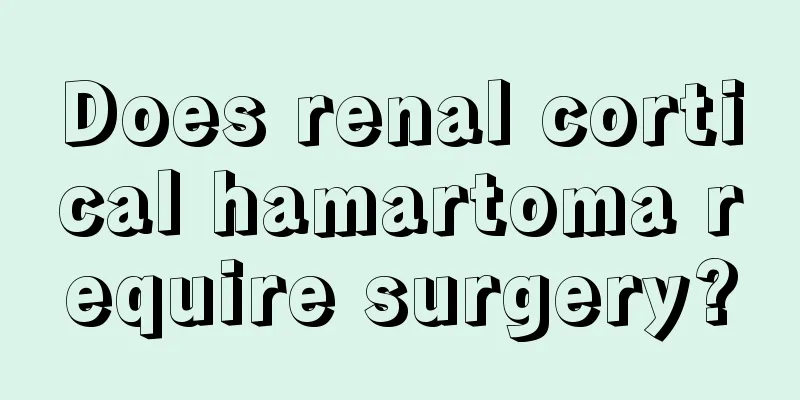Does renal cortical hamartoma require surgery?

|
The professional medical term for renal cortical hamartoma is renal hamartoma. Its cause is still unclear, but its formation is usually related to improper diet, abnormal work and rest, etc. Whether renal hamartoma requires surgery is generally related to the size of the tumor and the severity of the disease. Generally speaking, patients with small tumors and mild symptoms do not need surgery for the time being, while patients with large tumors or severe symptoms are recommended to take surgical treatment. Renal cortical hamartoma is a common benign kidney tumor, more professionally known as renal hamartoma. Most patients with renal hamartoma usually have symptoms such as waist and abdominal pain, abdominal mass, proteinuria, and hypertension, which seriously affect the patient's physical health and normal life. It is very necessary to receive treatment as soon as possible. So in the case of renal hamartoma, is it necessary to undergo surgery? Whether or not renal hamartoma requires surgery is closely related to the size of the tumor and the severity of the disease. For asymptomatic patients with tumors less than 4 cm in diameter, the treatment of the disease can be observed and followed up without temporary treatment; for patients with larger tumors or severe symptoms, surgical treatment is required as soon as possible. The main treatment goal of renal hamartoma surgery is to remove the tumor while protecting renal function as much as possible. It can generally be divided into three types: radiofrequency ablation, tumor enucleation, nephrectomy, and renal transplantation. At the same time, interventional embolization therapy and hemodialysis can be used as auxiliary treatment methods. The main working principle of radiofrequency ablation is to circulate and control high temperature to ablate the tumor, but this method has the disadvantage of incomplete tumor elimination, and often requires auxiliary treatments such as hemodialysis and interventional embolization; tumor enucleation refers to laparoscopic resection of the tumor, which is generally suitable for patients whose tumors are located at the edge of the kidney; and nephrectomy also includes partial nephrectomy and nephrectomy. This treatment method is extremely traumatic, so a decision needs to be made based on the patient's actual condition; if the patient's bilateral kidneys have lesions, resulting in loss of renal function or tumor rupture and massive bleeding, timely matching is required to strive for early renal transplantation. From the above content, we can know that if the renal hamartoma is small and has no special symptoms, surgery is not necessary, but surgery is recommended when the tumor is larger than 4cm. After surgery, patients should not take it lightly. They should not only closely observe the bleeding in the kidneys and pay attention to wound infection, but also pay attention to diet. For example, they can only start eating after gastrointestinal motility is restored after surgery, eat more fresh vegetables and beans, and control salt intake. These care measures are very helpful for recovering health as soon as possible. |
<<: Does renal hamartoma require surgery?
Recommend
What is the reason for teeth marks on the tongue
Many people will stick out their tongue to see if...
What should I do if my eyes blink dryly?
If your eyes are dry and you blink frequently, yo...
How to treat benign nasopharyngeal carcinoma
How to treat benign nasopharyngeal carcinoma? 1. ...
What to do if pancreatic cancer recurs and metastasizes
When it comes to pancreatic cancer, many people a...
I am sweating all over and feeling uncomfortable. What's going on?
Sweating is a normal physiological phenomenon of ...
How long can you live after having your uterus removed for malignant cervical cancer
In our lives, we often ignore our own health prob...
What's going on when I find my urine is very yellow when I go to the toilet?
Urine is excess water in the human body and other...
Chinese herbal medicine that promotes digestion and absorption
The human digestive system is generally divided i...
What causes painful breast lumps?
Breast lumps are painful, and the symptoms and ch...
What are the main symptoms of advanced liver cancer? The 6 most common symptoms of advanced liver cancer
1. Pain in the liver area: More than half of the ...
Can pregnant women drink chrysanthemum tea?
The daily diet of a postpartum woman is very impo...
Can Angelica remove melasma? How to remove spots?
The causes of chloasma are generally quite compli...
How to remove the fishy smell from stewed Spanish mackerel
Spanish mackerel is a common marine fish with hig...
Nursing after chemotherapy for colon cancer
There are many diseases that are ultimately treat...
What are the TCM diagnoses for brain cancer
The early symptoms of brain tumors are often atyp...









